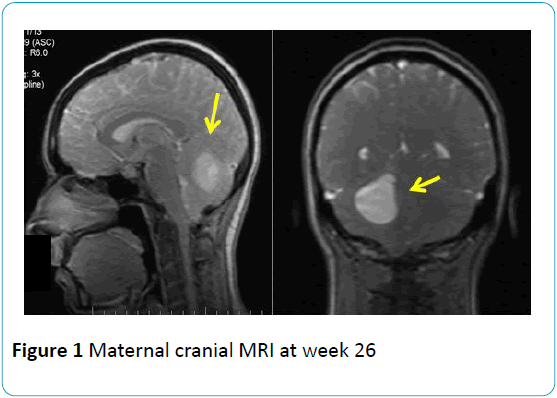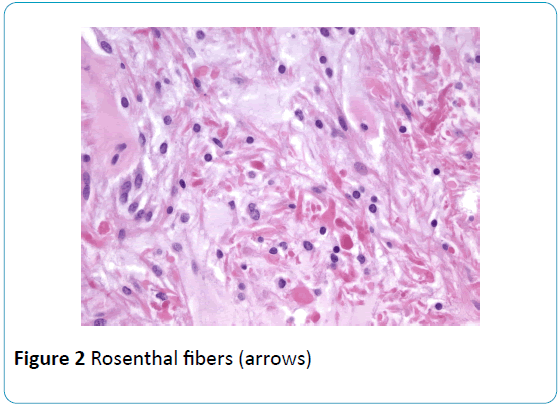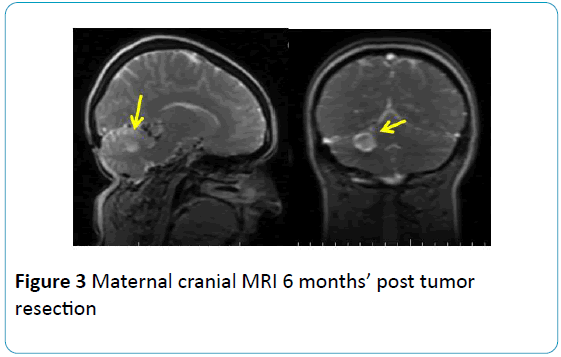Federico G Mariona* and Karen L Plymel
Michigan Perinatal Associates, Maternal Fetal Medicine, Beaumont Health, Dearborn, Michigan, USA
- *Corresponding Author:
- Federico G Mariona
Michigan Perinatal Associates, Maternal Fetal Medicine, Beaumont Health, Dearborn, Michigan,
USA
Tel: 1-313-593-5957
E-mail: fmariona@att.net
Received date: June 24, 2016; Accepted date: August 26, 2016; Published date: August 29, 2016
Citation: Mariona FG, Plymel LK. A Traditionally Pediatric Brain Tumor Diagnosed in the Second Trimester of Pregnancy; Index Case and Review
of the Database, Gynecol Obstet Case Rep. 2016, 2:2. doi: 10.21767/2471-8165.1000030
Keywords
Brain tumor; Pilocytic astrocytoma; Benign
childhood tumor; Neurosurgery; Pregnancy
Introduction
In a large 36-year institutional study involving 34 pregnant
women with intracranial lesions at an average maternal age of
27 ± 6 years no pilocytic astrocytomas were included [1,2]. PAs
are infrequently diagnosed in pregnancy [3]. As a
predominantly juvenile tumor it may have potentially serious
risks for maternal outcomes and presents additional long term
challenges to obstetricians. These patients are optimally
diagnosed and treated by a multidisciplinary team involving
obstetricians, neonatologists, radiologists, ethicists,
neurologists, neurosurgeons, oncologists, maternal fetal
medicine physicians and anesthesiologists. The natural history
of these tumors during pregnancy is variable, from rapid
maternal deterioration and neurologically unstable patients to
an indolent course allowing for a conservative approach. Brain
tumors in pregnancy have been reported to occur in 15/100,000 live births with variable perinatal outcomes [1].
The combination of brain tumor and pregnancy has been
variably considered “in no way rare” to “extremely seldom”
[4]. A query of our institution’s administrative database
(discharged patients) showed no brain tumors in pregnancy
(ICD-9 CM 239.6, 239.7 ICD-10 D43.2 D49.7) coded for the
period of January 1, 2004 to December 31, 2014,
approximately 33,000 live births.
Case Report
A 31-year-old gravida 2 para 1, presented to her
obstetricians for a routine prenatal care visit at 20 weeks’
gestation with complaints of persistent gastric intolerance. She
was diagnosed with hyperemesis gravidarum, hospitalized and
treated intermittently for 8 weeks. Preeclampsia was ruled
out. At 27 weeks’ gestation she noticed blurred vision,
diplopia, dizziness and right hand weakness. Her care was
transferred to Maternal Fetal Medicine. No cranial nerves
deficits or gait changes were elicited. Cranial imaging studies
via CT scan without gadolinium enhancement demonstrated a
5 cm cystic-solid mass in the right cerebellar lobe with mild
hydrocephaly and partially obliterated 4th ventricle (Figure 1)
[5].
Figure 1: Maternal cranial MRI at week 26
There was no evidence of intra or peri-tumoral hemorrhage.
Obstetrical ultrasound showed a single live fetus appropriately
grown, at 27 weeks’ gestation. Neuroradiology, neurology and
neurosurgery consultation was obtained, followed by neonatology and oncology. An additional neurosurgery
consultation followed, with the tentative diagnosis of
hemangioblastoma. Neurosurgery selected to access the
tumor and place an Ommaya reservoir under general
anaesthesia with simultaneous fetal monitoring, followed by
periodic fluid aspirations for cellular diagnosis [6]. The cellular
smear revealed a pilocytic astrocytoma (PA) World Health
Organization (WHO) grade I. The smear report was considered
not 100% diagnostic and opened to changes when tumor
tissue became available. The tumor size was mildly reduced
post fluid aspiration and the patient became asymptomatic. In
view of the cellular diagnosis, patient’s stable clinical situation
and following multidisciplinary team counselling the parents
opted for conservative therapy. The neurosurgical team
monitored the tumor behaviour and with the agreement of
the obstetrical team allow the pregnancy to continue in the
absence of maternal or fetal deterioration. Three fluid
evacuations through the Ommaya reservoir were performed;
no malignant cells were reported. The parents were counselled
regarding these findings and informed that the cellular
diagnosis may be discordant with the tissue diagnosis at the
time of the tumor resection. At 37 weeks’ gestation she
delivered a male fetus weighing 3033 g with Apgar scores of 5
and 8 at 1 and 5 minutes respectively via cesarean under
general anaesthesia. A week later an arteriogram was obtained
demonstrating no feeding vessels into the tumor mass. A sub
occipital craniotomy was performed with piece meal excision
of a right cerebellar multicystic-solid mass under
intraoperative stealth navigation microscopy. A drainage
system was placed in the posterior horn of the right ventricle.
Frozen section and definitive tissue diagnosis reconfirmed the
pilocytic astrocytoma WHO Grade I (WHO 1979), presenting
the characteristic Rosenthal fibers (Figure 2). Periodic MRIs
and CT scans without contrast were performed for follow up
during the ensuing 6 months. The ventricular drain was
removed. Images five months’ post-surgical excision showed a
cystic mass measuring 2.4 × 2.0 cm. with no evidence of new
or recurrent tumor (Figure 3). The patient returned to her
activities. She is now 20 months’ post treatment and
asymptomatic. The patient consent was waived as no personal
identifiers are utilized.
Figure 2: Rosenthal fibers (arrows)
Figure 3: Maternal cranial MRI 6 months’ post tumor
resection
Discussion
Pilocytic astrocytoma (PA), also called juvenile pilocytic
astrocytoma (JPA), or cystic cerebellar astrocytoma was
arguably first described by Percival Bailey in 1924 and Harvey
Cushing in 1931. None of these reports included a pregnant
patient [7]. PA is rare and mostly found in children. It is defined
as a juvenile, generally benign tumor that occurs most often in
children and young adults. It is reported to occur in 2/100,000
children 5 to 14 years old [8]. Bar et al. reported genomic
alterations in 25 cases of PA with tandem duplication on
chromosome 7q34 and increased BRAF genes with levels of
phosphorylated extracellular signal related kinase (ERK) and
nitrogen activated protein kinase (MEK) [9]. MEK-ERK signaling
may be associated with neurofibromatosis type I (NF1). JPA is
seen in up to 15% of patients with this inherited syndrome,
most commonly if the tumors involve the optic nerves. In
children, these tumors are usually slow growing as a single or
multiple cyst. When diagnosed in the adult the short and long
term effects, recurrence and malignancy rate varies; however,
the report does not include pregnant patients [10]. The
diagnosis of PA during pregnancy is infrequent. In a large study
querying the International Cancer in Pregnancy registration,
low grade astrocytoma was found in 22% of the 27 cases
reported between 1973 and 2012 [11]. PA is histologically
classified as grade I by the World Health Organization (WHO).
There is no available evidence demonstrating that pregnancy
increases the growth of Grade I PA as it has been documented
with Grade II gliomas [12].
We present a case of a cerebellar tumor discovered at 26
week’s gestation in an otherwise healthy 31-year-old woman.
This patient had no clinical life history of neurological events,
and went through a full term previous pregnancy with no signs
or symptoms of an intracranial space occupying mass. The
tumor was diagnosed originally via cellular smears from fluid
aspirated from the cyst as a Grade I pilocytic astrocytoma. This
was reconfirmed by tissue diagnosis at the time of the surgical
resection. The immediate maternal and neonatal results have
been good. We consider the primary diagnosis of pilocytic
astrocytoma in a pregnant adult infrequent, thereby this case
submission. Traditionally, brain tumors during pregnancy are
evaluated and treated by a multidisciplinary team as was in
this case. These tumors are generally diagnosed in very young individuals, 75% occurring in the first two decades of life. Di
Muzio et al. reported that PAs are the most common primary
brain tumors of childhood and account for approximately 70%
to 80% of all cerebellar astrocytomas and for 2% of all brain
tumors [13]. They may occur in any area of the brain stem or
spine where astrocytes are present. A classic juvenile grade I
astrocytoma is generally a benign non infiltrating tumor of
slow growth and usually follows a rather protracted course. Brain tumors in pregnancy pose a diagnostic and therapeutic
dilemma to the treatment team due to the scant population
based studies and evidence-based neurosurgical guidelines for
pregnant patients. An extensive retrospective cohort study
identified 437 benign brain tumors among 19 million
pregnancy-related admissions through the nationwide
inpatient sample (NIS) [14]. No report of a Grade I pilocytic
astrocytoma in pregnancy is included (Table 1).
| Author |
Study |
# of cases |
Histology |
Resection |
Delivered |
| Terry AR [14] |
Retrospective |
437 |
Benign (?) |
19% |
61% |
| Cohen-Gadol A [2] |
Retrospective |
34 |
GBM, Astro II and III |
78% |
57% |
Table 1: Intracranial tumors in pregnancy, no pilocytic astrocytoma included
A diagnosis of hyperemesis gravidarum showed an OR ratio
of 2.8 in the presence of benign brain tumors in pregnancy.
Similarly, there is an increased risk for cesarean delivery (OR
2.8) and hospitalization (OR 4.3). One third of those patients
ended with a neurosurgical approach either during, at the time
of delivery or in the post-partum period, depending on the
maternal-fetal clinical situation. Pregnancy complications were
not more likely to occur in these surgical patients. The authors
of the report emphasize that additional research is needed to
improve the understanding of obstetric risk in these patients and to further assist with counselling, monitoring, treatment
and follow up. Currently there are no evidence-based
guidelines to follow on patients diagnosed with brain tumors
during pregnancy. Due to the specificity of the diagnosis we
selected to limit our search for documented outcomes of
pilocytic astrocytomas (PA) WHO Grade I in pregnancy, surgical
and clinical outcomes in adults. A number of existing studies
have not addressed the combination of PA and pregnancy
[15-17] (Table 2).
| Author |
Study |
# of cases |
Complete Resection |
Recurrence |
Algorithm |
| Dirven [15] |
Retrospective |
73 |
69% |
19% |
Offered |
| Cyrine [16] |
Retrospective |
32 |
43.7% |
3.1% |
|
| Ye [10] |
Retrospective |
20 |
|
30% |
|
| Galgano [18] |
Case |
1 |
Drain, resection |
|
|
Table 2: Cerebellar pilocytic astrocytoma, Non pregnant patients
Extant case reports and reviews of the literature have
traditionally included single case reports or all-inclusive benign
intracranial tumors during pregnancy. The optimal treatment
of PAs is not limited to optimal resection, if the tumor location
allows it with careful handling to avoid spread of tumor cells,
metastasis and possible need for radiation therapy. It also
includes serial post treatment follow up with MRI to elicit any
local or regional tumor changes or recurrence. PA is usually
considered a benign childhood tumor. Some clinical
presentations such as partial resection, brainstem location and
adult age at discovery have a worse prognosis [15,16]. Overall
surgical and progression-free survival rates were reported as
87% and 60% respectively. Unfavourable outcomes were
observed in adults compare with a younger population [7].
Less than 5% of pilocytic astrocytomas progress towards
malignancy [18]. Due to the absence of clinical indication of an
intracranial space occupying mass in this patient, we selected
to submit the report to alert clinicians to the need to rule out
brain tumor during pregnancy. During pregnancy, the diagnosis
of hyperemesis gravidarum may need reconsideration even
before overt neurological signs and symptoms appear in the advanced second trimester. It is plausible that this tumor was
present in this patient since her infancy and remained silent.
Conversely, there is no evidence that gestational changes may
influence the behaviour of the tumor. Rarely intratumor
hemorrhage occurs in pilocytic astrocytomas [19]. White et al
reported pilocytic astrocytomas diagnosed in adults, mean age
23 years old, 8% with hemorrhage, 6 of them in female
patients, none of them diagnosed during pregnancy [20].
Conclusion
The diagnosis of a maternal intracranial tumor during
pregnancy is infrequent. A pilocytic astrocytoma diagnosed
during pregnancy at age 31 presents a distinct challenge for
the treatment team. These tumors are usually discovered
during childhood and are considered benign. In the adult the
behaviour of the tumor and the association with genetic
aberrations increase the chance to become malignant or recur
[21]. That is the primary reason for this case report. The
histopathology of the tumor and the patient’s age need a
complete understanding of the molecular variations of pilocytic astrocytomas and when needed, search for
molecularly targeted treatment if available [16] (Table 3).
| Author |
Study |
# of cases |
Histology |
Treatment |
| Verheecke [11] |
retrospective |
6 |
low grade II astrocytoma |
resection, RT*, CT* |
| Hong [17] |
case |
1 |
pilocytic astrocytoma gr 1 |
resection |
| Haas [4] |
retrospective |
9 |
astrocytoma I |
|
| *RT. Radiotherapy *CT chemotherapy |
Table 3: Astrocytoma in pregnancy (low grade)
Genetic counselling may be desirable. We understand that
there are no guidelines for the treatment of maternal brain
tumors in pregnancy. Nevertheless, guidelines are usually not
binding or otherwise they are not followed religiously. In the
era of evidence-based medical practice we offer the following
teaching points for this case; 1. In the rare case of a maternal
brain tumor, a multidisciplinary team must be assembled to
arrive at a prompt diagnosis, adequately counsel the family,
and decide a course of therapy. 2. If feasible, and according
with the established diagnosis, continue the care of the
pregnancy while be prepared for any maternal or fetal medical
or surgical emergent contingency. The diagnosis allows for
targeted therapy or conservative treatment as appropriate. 3.
A pregnant woman with persistent and unremitting nausea,
vomiting, dizziness must be fully evaluated in spite of the rarity
of a brain tumor in pregnancy. These concerns are usually
followed by the treatment team and may serve as a
springboard to establish standards of care. There is an
opportunity for further research regarding the variable
behaviors of these juvenile tumors during pregnancy. Short
and long term follow up, expanded patient work up to arrive at
a complete picture with clinical relevance for additional
treatment when indicated and long term prognosis follows.
The authors recommend that each new case of PA in
pregnancy and its clinical outcome be reported to the National
Registry to allow pertinent clinical information to be readily
available for obstetrical practitioners and the entire health
care team.
References
- Lew PS, Tan WC, Tan WK, Tan HK (2010) Dilemmas in management of brain tumors in pregnancy. Annals Academy of Medicine 39: 64-65.
- Cohen-Gadol AA, Friedman JA, Friedman JD, Tubbs RS, Munis JR, et al. (2009) Neurosurgical management on intracranial lesions in the pregnant patient: a 36-year institutional experience and review of the literature. J Neurosurg 111: 1150-1157.
- Ravindra VM, Braca JA, Jensen RL, Duckworth EAM (2015) Management of intracranial pathology during pregnancy: case example and review of management strategy. Surg Neurol Int 6: 43-56.
- Haas JF, Janisch W, Staneczek W (1986) Newly diagnosed primary intracranial neoplasms in pregnant women: a population based assessment. J Neurol Neurosurg and Psychiatry 49: 874-80.
- Webb JAW, Thomsen HS (2013) Gadolinium contrast media during pregnancy and lactation. Acta Radio 54: 599-600.
- Giovanini MA, Mickle JP (1996) Long term access to cystic brain stem lesions using the Ommaya reservoir: technical case report Neurosurgery 39: 404-407.
- Cushing H (1931) Experiences with the cerebellar astrocytomas, a critical review of 76 cases. Surg. Gynecol-Obstet 52: 129-204.
- Available from https://www.hersentumor.nl access August 10, 2016.
- Bar EE, Lin A, Tihan T, Burger PC, Eberhardt CG (2008) Frequent gains at chromosome 7q34 involving BRAF in pilocytic astrocytoma. J Neuropathol Exp Neurol 67: 878-887.
- Ye JM, Ye MJ, Kranz S, Lo P (2014) A 10-year retrospective study of surgical outcomes of adult intracranial pilocytic astrocytoma. J. Clin Neurosci 21: 2160-2164.
- Verheecke M, Halaska MJ, Lok CA, Ottevanger PB, Fruscio R, et al. (2014) Primary brain tumors, meningiomas and brain metastasis in pregnancy: report of 27 cases and review of literature. Eur J Canc 50: 1462-1471.
- Pallud J, Mandonnet E, Deroulers C, Fontaine D, Badoual M, et al. (2010) Pregnancy increases the growth rates of World Health Organization grade II gliomas. Ann Neurol 67: 398-404.
- Di Muzio B, Gaillard F (2015) MRI grading versus histology: predicting survival of World Health Organization grade II-IV astrocytomas. AJNR AM J Neuroradiol 36: 77-83.
- Terry AR, Barker II FG, Leffert L, Bateman BT, Souter I, et al. (2012) Outcomes of hospitalization in pregnant women with CNS neoplasms: a population-based study. Neuro Oncol 14: 768-776.
- Dirven CM, Mooij JJ, Molenaar WM (1997) Cerebellar pilocytic astrocytoma: a treatment protocol based upon analysis of 73 cases and a review of the literature Childs Nerv Syst 13: 17-23.
- Cyrine S, Sonia Z, Mounir T, Badderedine S, Kalthoum T, et al. (2013) Pilocytic astrocytoma: a retrospective review of 32 cases. Clin Neurol Neurosurg 115: 1220-1225.
- Hong CS, Lehman NL, Sauvagean E (2014) A pilocytic astrocytoma mimicking a clinoidal meningioma. Case reports in Radiology Article ID 524574.
- Dirks PB, Jay L, Becker LE (1994) Development of anaplastic changes in low grade astrocytomas of childhood. Neurosurgery 34: 68-78.
- Galgano M, Padalino DJ, Fullmer J, Krishnamurthy S (2014) Acute neurological deterioration in an adult with a cerebral pilocytic astrocytoma accompanied by intratumoral hemorrhage, subdural hematoma and obstructive hydrocephalus Crues 6: e235.
- White JB, Piepgras DJ, Scvheithauer BW, Parisi JE (2008) Rate of spontaneous hemorrhage in histologically proven cases of pilocytic astrocytoma. J Neurosurg 108: 223-226.
- Sadighi Z, Slopis J (2013) Pilocytic astrocytoma: a disease with evolving molecular heterogeneity. J Child Neurol 28: 625-632.




